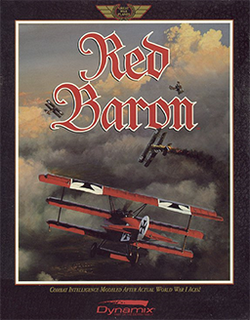
Red Baron is a combat flight simulation video game for MS-DOS created by Damon Slye at Dynamix. It was published by Sierra On-Line in 1990.

Falcon 4.0 is a combat flight simulation video game developed by MicroProse and published by Hasbro Interactive in 1998. The game is based around a realistic simulation of the Block 50/52 F-16 Fighting Falcon jet fighter in a full-scale modern war set in the Korean Peninsula. Falcon 4.0's dynamic campaign engine runs autonomously.

Flight Unlimited is a 1995 aerobatic flight simulator video game developed and published by LookingGlass Technologies. It allows players to pilot reproductions of real-world aircraft and to perform aerobatic maneuvers. They may fly freely, race through floating rings against a timer or take lessons from a virtual flight instructor. The instructor teaches basic and advanced techniques, ranging from rudder turns to maneuvers such as the tailslide, Lomcovák and Immelmann turn.

Red Baron II is a video game for the PC, developed by Dynamix and published by Sierra On-Line. It is the follow-up to the flight simulation Red Baron, released in 1990. Red Baron II was released in December 1997. A patch was released in 1998 that added support for 3D acceleration and renamed the game to Red Baron 3D. Red Baron 3D was also released as a retail product.
Combat flight simulators are vehicle simulation games, amateur flight simulation computer programs used to simulate military aircraft and their operations. These are distinct from dedicated flight simulators used for professional pilot and military flight training which consist of realistic physical recreations of the actual aircraft cockpit, often with a full-motion platform.

Star Wars: X-Wing is a space simulation video game, the first of the X-Wing combat flight simulation games series. The player's character flies starfighters, including the eponymous X-wing, for the Rebel Alliance as part of a narrative that precedes and parallels the events of Star Wars Episode IV: A New Hope.

Ace Combat 2 is a 1997 air combat video game developed and published for the PlayStation by Namco. It is the sequel to Air Combat and the second in the Ace Combat franchise. The player controls one of 24 different fighter jets through 21 different missions with certain objectives to fulfill, such as protecting a base from enemy fire, intercepting a squadron of enemies, or taking down an aircraft carrier.
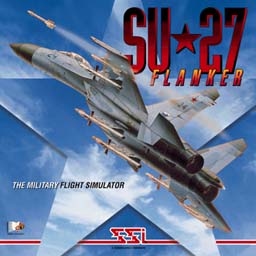
Su-27 Flanker is a combat flight simulator released for the PC in 1995 on CD. Developed in Russia by Eagle Dynamics and published by Strategic Simulations, Inc (SSI), the game takes part in Crimea and allows players to fly the SU-27 aircraft in various combat roles. The game also includes a mission editor, allowing the player to create custom gameplay scenarios.

AH-64D Longbow is a realistic combat flight simulator of the AH-64D Apache Longbow attack helicopter. Released on May 31, 1996 for the PC, this simulation was developed at Origin Systems. AH-64D Longbow was the second simulator released under the Jane's Combat Simulators line from Electronic Arts.
Microsoft Flight Simulator began as a set of articles on computer graphics, written by Bruce Artwick throughout 1976, about flight simulation using 3-D graphics. When the editor of the magazine told Artwick that subscribers were interested in purchasing such a program, Artwick founded Sublogic Corporation to commercialize his ideas. At first the new company sold flight simulators through mail order, but that changed in January 1979 with the release of Flight Simulator (FS) for the Apple II. They soon followed this up with versions for other systems and from there it evolved into a long-running series of computer flight simulators.

MechWarrior 2: 31st Century Combat is a vehicle simulation game developed and published by Activision, released in 1995 as part of the MechWarrior series of video games in the BattleTech franchise. The game is set in 3057, and is played as a tactical simulation that incorporates aspects of real-time first-person combat and the physical simulation of the player's mech. It is a game recreation of the "Refusal War." The player can join one of the clans, Clan Jade Falcon or Clan Wolf while engaging in up to 32 missions.
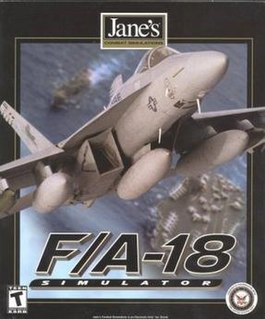
Jane's F/A-18 is one of the final study flight simulators by Electronic Arts under Jane's Combat Simulations brand, the sequel to the highly successful Jane's F-15. Jane's F/A-18 was released in early 2000; it simulates the F/A-18E Super Hornet and carrier-based aviation in a fictional campaign around the Kola Peninsula during a Russian civil war. It comes with a mission builder as well as a campaign builder. Fans have created content such as new cockpits, enhanced graphics, new aircraft, vehicles, and also the Persian Gulf area ported from Jane's F-15 as the games shared the same graphics engine.

TFX is a 1993 combat flight simulator video game developed by Digital Image Design and published by Ocean Software that was released for DOS and Amiga computers.

Hind is combat flight simulation game released by Digital Integration in 1996 for MS-DOS compatible operating systems and Microsoft Windows. It is the successor to Apache Longbow.
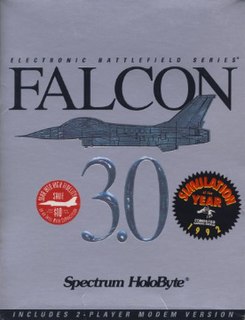
Falcon 3.0 is a combat flight simulator video game developed by Sphere Inc. and published by Spectrum HoloByte in 1991 as third official main entry in the Falcon series of the F-16 Fighting Falcon simulators.

MiG Alley is a combat flight simulation game, developed by Rowan Software for PCs with Windows, and was published by Empire Interactive in 1999.

Star Wars: TIE Fighter is a 1994 Star Wars space flight simulator and space combat video game, a sequel in the Star Wars: X-Wing series. It places the player in the role of an Imperial starfighter pilot during events that occur between The Empire Strikes Back and Return of the Jedi.
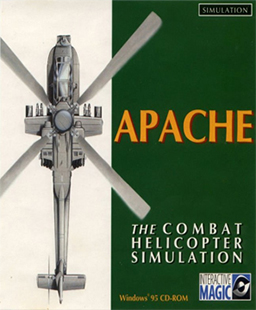
Apache is a video game released by Digital Integration in 1995 for DOS and Macintosh. The game is a combat flight simulation of the American AH-64D Apache Longbow helicopter. A successor, Hind, was released in 1996.
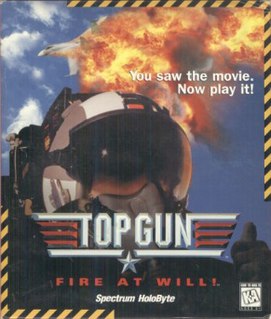
Top Gun: Fire at Will is a video game developed and published by Spectrum HoloByte for DOS, Windows, PlayStation, and Mac OS. It is a licensed game in the Top Gun franchise. A sequel, Top Gun: Hornet's Nest, was released in 1998.

Jane's ATF: Advanced Tactical Fighters is a 1996 combat flight simulator developed and published by Electronic Arts for DOS. It is part of the Jane's Combat Simulations franchise. An expansion pack, NATO Fighters, was released in 1996. A compilation package, Advanced Tactical Fighters Gold, was released in 1997 for Microsoft Windows.


















